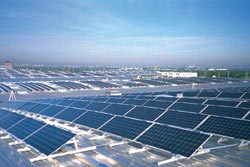While the global economy may be taking a nosedive, it surely does not spell doomsday for the solar industry.
Sure, solar stocks are down, as are installations, and financing has slowed to a trickle. But it’s all relative. All were booming a year ago and had far to fall. Overall, analysts agree that solar’s here for the long term, and we just need to sit tight, expect change and know that the industry will be alive and well beyond 2010.

Solar was booming last year and had far to fall, but analysts agree that the industry is here to stay. Photo courtesy of Shell Solar BV.
A shakeout is about to take place in the photovoltaic (PV) industry, according to several analysts. Greentech Media Research of Cambridge, Mass., and Chicago-based Prometheus Institute for Sustainable Development recently released the report 2009 Global PV Demand Analysis and Forecast, which predicts a shakeout in the module industry, driven by pricing pressure that’s spurred by developers looking for the lowest price.
Daniel Englander, senior energy analyst at Greentech Media and author of the report, said that the way to differentiate in this market is either price or performance. He cited First Solar as an example of a high-quality manufacturer with the lowest cost per watt of anyone in the business. He pointed to San Jose, Calif.-based SunPower, which makes a multicrystalline module with a conversion efficiency of 24 to 25 percent.
As far as which technology will dominate, the Greentech report sees Asian multicrystalline and copper indium gallium selenide dominating in the near term, but it forecasts that by 2012, thin-film modules will make up half the modules installed. Gartner of Stamford, Conn., is expecting that the thin-film module market will grow from 800 MW in sales in 2008 to 1.7 GW in 2009. This is an increase of more than 110 percent, despite the lack of financing in Germany and the US for large-scale projects.
On the module side, there’s good news and bad news. The good news is that module prices will tumble below $2.50 per watt this year, resulting from financing pressures, according to the Greentech report, and then will drop further to about $2 per watt in 2010. The bad news is that cell and module supply will be twice the demand by 2009, according to Boston-based Lux Research. But that’s not all that bad because price reductions will push solar to grid parity, enabling the industry to grow to $70 billion across 18.5 GW in 2013, according to the Lux analysts.
Grid parity – the long-anticipated goal of solar – will be realized this year, according to Englander. Other markets will reach the goal in 2011 or 2012, depending on several factors such as module technology, electricity rates and project design. Among the first projects expected to achieve this are residential rooftop crystalline silicon systems in Japan and commercial thin-foil rooftop projects in California. “While there are lots of caveats, it’s still good news,” Englander said, adding that Japan will achieve grid parity by next year.
The money flow
A small storm cloud lingered over the US solar industry as it waited for the solar energy tax credit to be extended. It was, but now with the downturn in the economy, investors are not lining up to offer power purchase agreements. Solar power purchase agreements are contracts in which a provider, such as Chicago-based Perpetual Energy Systems (See “Backing for Solar Ripens in Napa Valley”), offers power to a customer, who agrees to purchase solar power at a set rate for a determined amount of time. The provider pays to install and maintain the solar, and customers pay for just the power generated. It used to be that companies used solar power purchase agreements to write off their tax burden, but as Englander explained, “Now a lot of people don’t have tax burdens because they don’t have revenues.” He thinks there will be a big switch away from power purchase agreements and toward utilities taking the lead by integrating renewables into their portfolios.
Integration is what will keep module makers’ heads above water in the next year or so, according to Englander. Companies such as Suntech Power Holdings of Wuxi, China, will fare best because it does it all – from polysilicon and wafer manufacturing to panel production and project management. Certainly not every company has to do it all to survive, but “Any integration is better than no integration at all,” Englander said.
And there’s further light at the end of the tunnel. Overall solar demand and financing may get a boost from the extension of the solar investment tax credit in the US, as well as from the stimulus package. The German market also remains strong, with new potential seen in the French, Portuguese, Korean and Italian markets. The “buying proposition is pretty compelling,” Englander noted. “Those that are installed are producing energy; the cost is fixed and stable.” He explains the recent stock tumble as a correction to overvalue, adding that “the fact that they’re going down has nothing to do with the viability of solar.”
This month’s “GreenLight” section focuses on research, new approaches to electrical design, enhanced quality control techniques, exciting installations with full financing – and an artistic use of solar and light, all indicating that the solar industry is, indeed, moving forward with optimism.